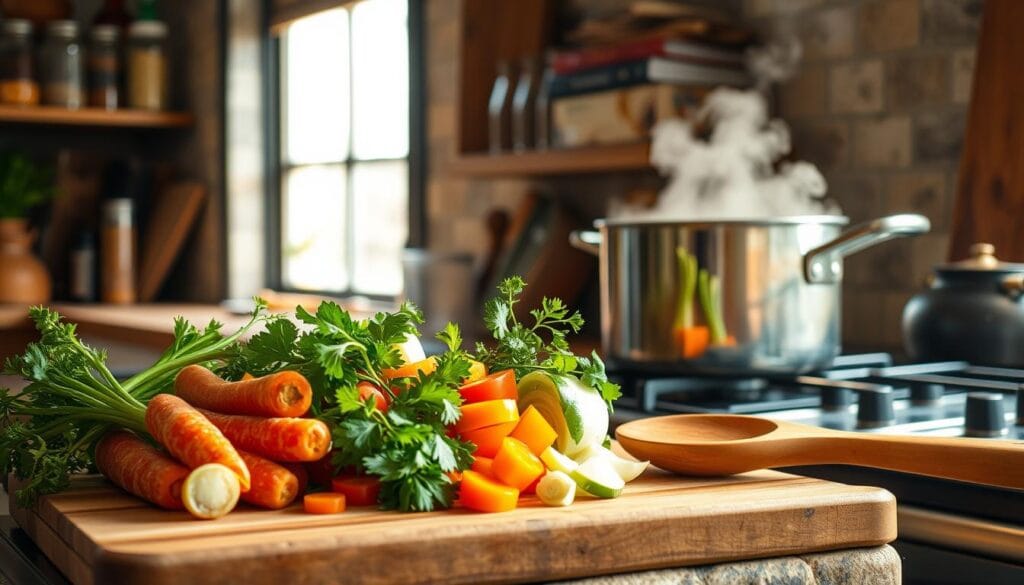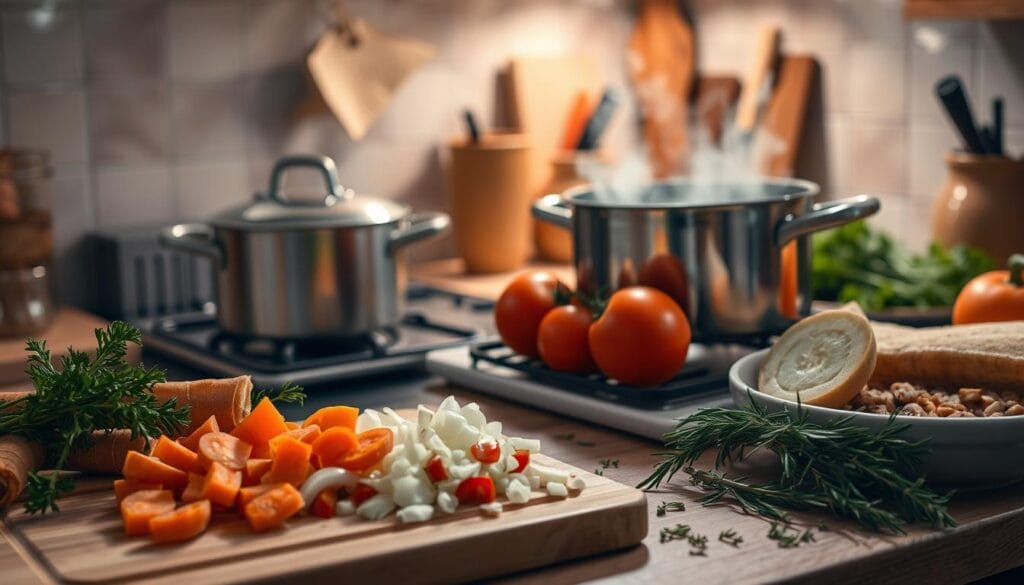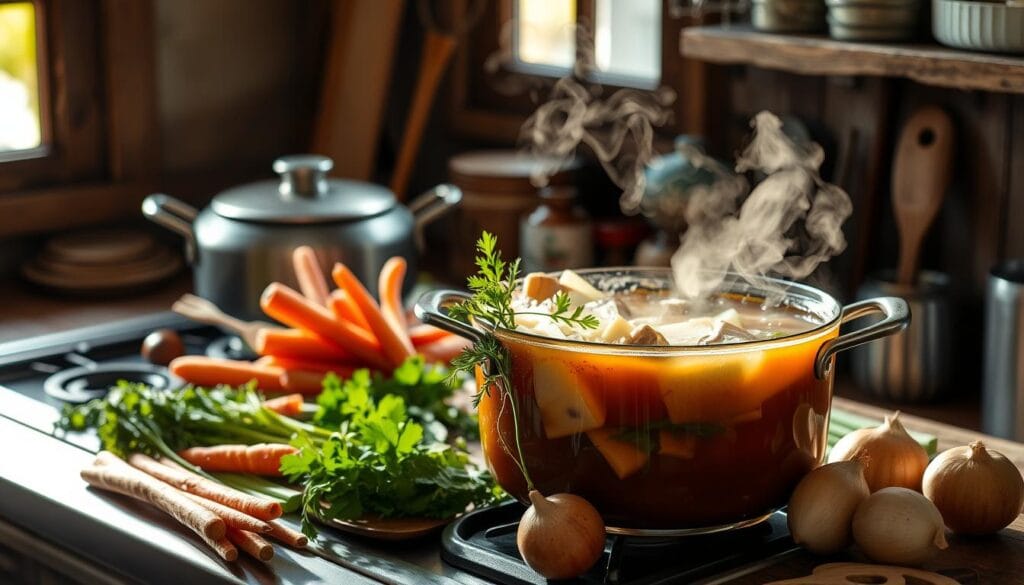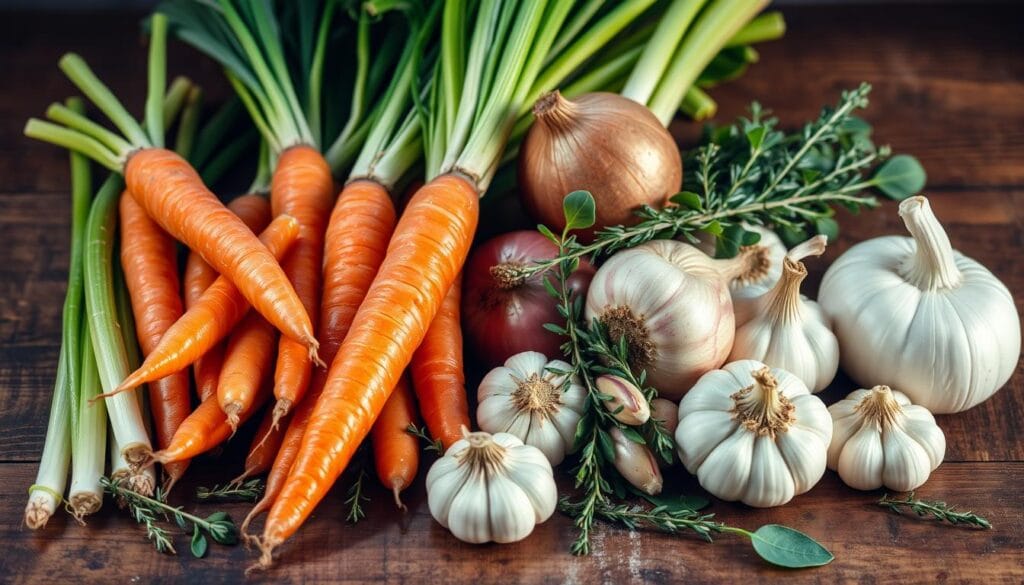There’s nothing like a warm bowl of homemade soup on a cold day. Whether it’s chicken noodles or butternut squash, making good soup is a skill many love. I’ve spent hours in the kitchen learning the secrets to great soup flavors.
Main Highlights :
- Up to 75% of a soup’s flavor comes from the broth used
- Fresh herbs can significantly enhance the taste of a soup when added at the end
- Layering ingredients during cooking builds complexity and depth of flavor
- Proper seasoning throughout the process is essential for well-balanced soups
- Incorporating aromatic vegetables and a Parmesan rind can elevate the overall taste
Understanding the Fundamentals of Soup Making
Learning to make soup is all about knowing the basics. You need the right tools, ingredients, and understanding of different soups. Whether you’re a pro or just starting, learning these basics can help you make a delicious soup.
Essential Kitchen Equipment for Soup Preparation
The right tools are key in soup-making. A Dutch oven is essential for even cooking and has rich flavors. You also need a sharp knife and a good cutting board for chopping ingredients.
Basic Ingredients Every Soup Needs
- Aromatic vegetables like onions, celery, and carrots are the base of many soups.
- Good stock or broth is crucial for the soup’s liquid base.
- Proteins like chicken, beef, or legumes make a soup hearty and nutritious.
- Herbs and spices add flavor and aroma to your soup-making.
Understanding Soup Varieties
Soups come in many types, each with its own taste and experience. From clear broths to cream-based soups and hearty stews, knowing these can guide your choice of ingredients and cooking methods. Exploring these options can inspire you to create your soup recipes.

By learning the basics of soup-making, you’ll soon be making delicious soups that everyone will love. These tips are great for both new and experienced cooks, helping you on your soup-making journey.
What Is the Secret to Making Good Soup
The secret to making great soups is simple. Start with a homemade, flavorful stock or broth. This is key, as 80% of great soups begin with quality stock. Also, add fresh herbs and aromatic vegetables like onions, carrots, and celery for extra flavor.
Layering ingredients is crucial. First, sauté onions, carrots, and celery with a bit of salt until they’re soft. Then, add herbs and spices. Finish by deglazing the pan with broth, wine, or tamari. Add the main ingredients and stock, tasting and adjusting as you go.
The “FASS” method is also helpful. It means balancing Fat, Acid, Salty, and Sweet. Adding nut creams, herb sauces, or crispy toppings can make your soup unforgettable.
| Ingredient | Role in Soup Making |
|---|---|
| Homemade Stock | Provides a depth of flavor |
| Fresh Herbs | Add dimension and aroma |
| Aromatic Vegetables | Build complexity in the base |
| Acid (e.g., lemon juice, vinegar) | Balances flavors and brightens the soup |
| Parmesan Rind | Adds richness and umami |
By using these tips, you’ll make a perfect soup recipe. It will taste amazing and impress everyone.

Mastering the Art of Homemade Stock
Homemade stock is key to making delicious soups. Making your stock from scratch brings out flavors that store-bought broths can’t. Learning to make homemade stock will make your soups better and more enjoyable.
Different Types of Stock Bases
There are many stock bases to choose from, each with its taste. Here are some common ones:
- Chicken stock: Made from simmering roasted chicken bones and aromatic vegetables.
- Vegetable stock: Crafted by simmering a mix of vegetable scraps and aromatics.
- Beef stock: Derived from simmering beef bones and connective tissues.
- Fish stock: Made by simmering fish bones, shells, and aromatic vegetables.
Stock Storage and Preservation Tips
To keep your homemade stock fresh, follow these tips. Cool the stock completely before putting it in airtight containers. Store it in the fridge for up to 4 days or in the freezer for up to 3 months. Thaw it in the fridge overnight when you’re ready to use it.
Common Stock-Making Mistakes to Avoid
While making homemade stock is easy, there are mistakes to avoid:
- Oversalting: Don’t add too much salt, as it can overpower the stock’s flavors.
- Failing to skim impurities: Skim the stock’s surface often to keep it clear and pure.
- Overcooking: Avoid long-simmering, as it can make the stock cloudy and bitter. Aim for a gentle simmer.
Mastering homemade stock will help you make amazing soups. Enjoy the process, try different stock bases, and see the results of your hard work.

The Power of Aromatic Vegetables in Soup Making
Making a tasty soup starts with picking the right veggies. Aromatic ingredients are key to making your ingredients for tasty soup and flavorful soup recipes stand out. Onions, celery, and carrots, known as the French mirepoix, show how simple veggies can make a big flavor difference.
To get the most from your veggies, sauté them in fat like olive oil or butter until they’re soft. This step, called sweating, brings out their natural sweetness. It makes your soup taste amazing. Remember to add garlic later to avoid it getting bitter.
But more veggies can add flavor to your soup. Leeks, fennel, and bell peppers are great examples. They each bring their taste and smell. Try mixing them to find the perfect flavor for you.
| Aromatic Vegetable | Flavor Profile | Suggested Uses |
|---|---|---|
| Onions | Sweet, savory, and caramelized | Mirepoix base, sautéed for depth |
| Celery | Earthy, slightly bitter, and refreshing | Mirepoix base, adds crunch and texture |
| Carrots | Sweet and subtly earthy | Mirepoix base provides color and sweetness |
| Garlic | Pungent, savory, and umami-rich | Sauté towards the end to prevent bitterness |
| Leeks | Mild onion-like flavor with a touch of sweetness | Substitute or complement mirepoix |
| Fennel | Licorice-like aroma and slight anise flavor | Add depth and complexity to soups |
| Bell Peppers | Ranging from sweet to spicy, depending on the color | Enhance flavor and provide vibrant colors |
Using aromatic veggies, you can make a great base for your ingredients for tasty soup and flavorful soup recipes. Your soup will be full of rich, layered flavors.

Proper Seasoning Techniques for Flavorful Soups
Seasoning is key to making delicious soups. It turns simple ingredients into a feast for the senses. Let’s dive into the secrets of layering flavors and balancing tastes.
Essential Herbs and Spices for Soup
Boost your soup’s flavor with the right herbs and spices. Here are some must-haves:
- Parsley: Adds a fresh, herbaceous note
- Thyme: Imparts a warm, earthy flavor
- Bay leaves: Lend a subtle complexity
- Cumin: Adds a smoky, slightly nutty undertone
- Paprika: Provides a gentle sweetness and vibrant color
When to Add Seasonings
Timing is everything when seasoning your soup. Start with a pinch of salt on the aromatics like onions and garlic. This boosts their taste.
Then, add dried herbs and spices after the aromatics cook but before the liquid. This lets the flavors mix well. Finally, add fresh herbs at the end to keep their aroma and taste bright.
Balancing Flavors in Your Soup
Getting the flavors right is crucial for a great soup. Taste and adjust as you go. A bit of acid, like lemon juice, can brighten the taste.
With seasoning skills, you’ll make soups that wow everyone. Remember, the right seasoning is what makes a soup truly great.
Creating Rich and Creamy Soups Without Dairy
Creating rich and creamy soups without dairy is easy. You can use pureed veggies, nuts, and plant-based milks. This way, you make soups that are tasty and fit many diets.
Pureed veggies like potatoes or cauliflower add creaminess and texture. Blend some cooked veggies until smooth, then mix them back into the soup. This makes the soup creamier and adds nutrients. You can also use blended nuts, like cashews or almonds, for a creamy base.
Coconut milk is a great dairy-free alternative. It adds a sweet taste and a creamy feel. Cornstarch or arrowroot powder can also thicken soups like heavy cream or butter.
| Dairy-Free Soup Thickening Methods | Advantages |
|---|---|
| Pureed vegetables (e.g., potatoes, cauliflower) | Adds natural creaminess and nutrients |
| Blended nuts (e.g., cashews, almonds) | Creates a rich, creamy base |
| Coconut milk | Provides a dairy-free, luscious texture |
| Starches (e.g., cornstarch, arrowroot) | Effectively thickens soups without dairy |
These soup-cooking techniques help you make perfect soup recipes. They are rich and creamy and fit many diets. Try different thickeners to find the best mix for your soups.
Mastering Soup Textures and Consistency
Getting the right texture and consistency is key for making tasty soups. You might want a smooth bisque or a chunky chowder. Learning how to thicken and adjust the soup’s consistency is important.
Thickening Methods for Soups
There are many ways to thicken your soup. Here are a few:
- Adding starches like flour or cornstarch for a creamy texture.
- Pureeing some of the soup for a smooth base.
- Use dairy like heavy cream or yogurt for creaminess.
When thickening clear broths, be careful not to overdo it. This can mess up the soup’s taste and look.
Achieving the Perfect Consistency
To get the right consistency, start by adding liquid slowly. Let the soup simmer and reduce it as needed. Cook pasta or rice separately to avoid a thick soup.
When reheating, you might need to add more broth or water. This is because starchy ingredients soak up the liquid. By watching and adjusting the texture, your soups will always be just right. This way, you’ll have soups that are secrets for delicious soup and perfecting soup texture at their best.
Time Management and Cooking Techniques
Making great soups is more than just using good ingredients. You also need to manage your time well and know how to cook. Most soups need 40-50 minutes of slow simmering. This lets the flavors mix well without the soup getting too thick.
Start by adding the ingredients that take the longest to cook first. Then add the quicker ones. Use pre-cooked items like canned beans or leftover meat towards the end. This keeps them from getting too soft or falling apart.
For soups with pasta or rice, add them in the last 20-30 minutes. This keeps them from getting mushy or too thick. The right timing and layering of ingredients are key to great soup cooking techniques.
| Soup Cooking Techniques | Benefits |
|---|---|
| Low and Slow Simmering | Allows flavors to develop, preserves texture of ingredients |
| Layered Ingredient Addition | Ensures proper cooking times for each component |
| Timed Addition of Pasta/Rice | Prevents overcooking and excessive thickening |
| Utilizing Pre-Cooked Items | Adds convenience without compromising flavor |
Learning these soup-cooking techniques will help you make great soup. It will be tasty and have the right texture. With some planning and care, your homemade soups will wow everyone.
Storage Solutions and Freezing Tips
Enjoying your favorite soup recipe doesn’t have to stop. You can keep your homemade soup fresh for weeks. Learn the best ways to store and reheat your soups to keep their taste and texture perfect.
Best Containers for Soup Storage
For storing soup, use airtight containers. Choose freezer-safe jars, Gladware Freezerware, or Souper Cubes. They keep soups fresh in the fridge for up to 4 days or in the freezer for 3 months. Make sure to leave some space at the top for expansion when freezing.
Reheating Methods That Preserve Flavor
Reheating soup is an art. Thaw frozen soup in the fridge before reheating it gently on the stovetop. Add broth or water if needed to get the right consistency. Always taste and adjust the seasonings after reheating, as flavors can change.
Mastering soup storage and reheating lets you enjoy your homemade soups for longer. With the right techniques, your soups will stay delicious and ready for any time you want them.
Common Soup-Making Mistakes to Avoid
Making delicious soup is an art. To make your soup great, avoid these common mistakes.
Don’t oversalt your soup. Vegetables and grains soak up salt. Season slowly and taste often to avoid too much salt. Too much liquid can also water down flavors. Start with a little broth and add more as needed.
Don’t overcook your ingredients. Lettuces and greens get slimy with too much heat. Meats can get tough and chewy. Cook each part just right to keep it perfect.
- Don’t boil soup too hard. It can ruin the texture and make the broth cloudy.
- Don’t add too many flavors. Too many can confuse your taste buds and make the soup muddy.
- Stay away from canned veggies. They can be mushy and taste bland.
Avoid these secrets for delicious soup mistakes to make perfect soup. Be patient, season slowly, and watch closely. Soon, you’ll be making great soup.
Conclusion
The secret to making good soup is a mix of techniques and details. Use quality ingredients, like homemade stock, for the best taste. Start with aromatic vegetables to build flavors.
Seasoning well during cooking is key. Try different herbs and spices to find the perfect mix. Pay attention to cooking times and temperatures for the right texture.
Many soups get better with time. So, make extra for tasty leftovers. With these soup-making tips and the secret to making good soup, you’ll make amazing homemade soups. Impress your family and friends with your cooking. So, put on your apron, grab your ladle, and start your soup-making journey.
FAQ
What are the key factors for making good soup?
Good soup needs a few key things. First, use homemade broth for a rich base. Add fresh herbs for extra flavor.
Layer ingredients while cooking to build complexity. Seasoning is key throughout the process for the best taste.
What are the different types of soups?
There are many soup types. You have clear broths, cream-based soups, and hearty stews. Knowing these helps pick the right ingredients and cooking methods.
Why is homemade stock crucial for flavorful soups?
Homemade stock makes soups taste better. You can make chicken, vegetable, beef, or fish stock. For vegetable stock, simmer scraps with aromatics. Use roasted chicken bones for chicken stock.
How do aromatic vegetables contribute to the flavor base of soups?
Aromatic veggies are the base of most soups. Onions, celery, and carrots make up the mirepoix. Chop them finely and cook slowly to release flavors.
What are the essential herbs and spices for seasoning soups?
Key herbs and spices include parsley, thyme, bay leaves, cumin, and paprika. Start with a pinch of salt when cooking veggies. Add dried herbs and spices after cooking aromatics but before adding liquid. Add fresh herbs at the end.
How do you adjust soup texture and consistency?
Adjust soup texture by adding starches, pureeing, or using cream. For clear broths, avoid thickening too much. Gradually add liquid and simmer to get the right consistency.
What are some effective time management and cooking techniques for great soup?
Good soup needs time and the right techniques. Cook most soups for 40-50 minutes at low heat. Add ingredients in order of cooking time.
How should soups be stored and reheated?
Store soups in airtight containers in the fridge for up to 4 days. Freeze in freezer-safe containers or bags for up to 3 months. Reheat slowly over low heat, adding broth or water as needed.

